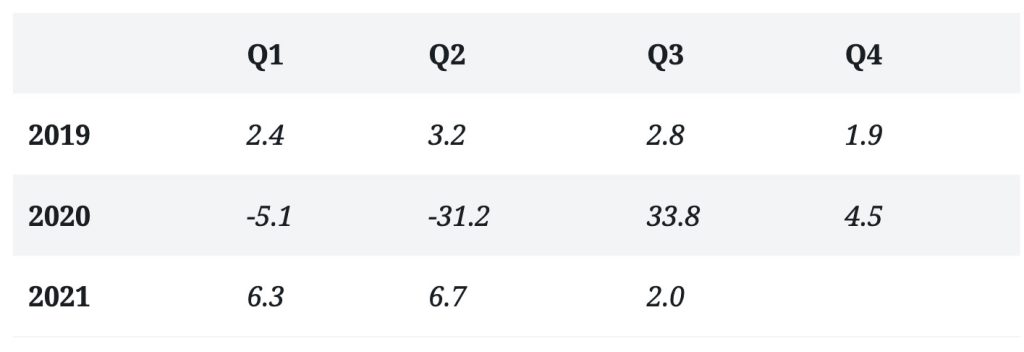

The events of the last two years are ones that few Americans thought they would ever see. The performance of the U.S. economy as we enter 2022 continues to be unprecedented in many ways. The gradual changes that typically occur in a normal business cycle for economic growth, the labor market, and inflation were replaced by significant COVID-driven volatility. The pandemic caused sudden and significant changes in economic growth, the labor market, and inflation. COVID created unprecedented economic and forecasting challenges for policy makers and businesses in the United States and globally. While COVID was the driving force in creating these changes and challenges, COVID also magnified structural vulnerabilities in supply chains.
Economic growth returned in 2021, but the labor market and inflation (including supply chain issues) presented challenges never seen before. This blog will review the economic growth of the past few years and then discuss the nuances and challenges created by the current economy. The blog consists of three parts:
- economic growth
- the labor market
- inflation
Economic Growth
After modest economic growth in 2019 and a significant downturn in 2020, consistent economic growth returned in 2021 despite a COVID rebound. The Bureau of Economic Analysis (BEA) compiles and publishes Gross Domestic Product (GDP) statistics, which measures the U.S. output of goods and services and is the benchmark for measuring economic growth. Quarterly GDP growth is usually expressed as a percentage that represents the rate at which U.S. economic output is either growing or contracting.
Looking at the percent change from the previous quarter at an annualized rate can be useful in identifying trends and comparing the economic growth of different quarters, particularly during an economic expansion or contraction. However, the annualized rate assumes that the rate of change in the recent quarter would basically continue for four consecutive quarters, with some adjustments for seasonality and compounding effects.
Table 1 below shows quarterly economic growth at an annualized rate since 2019 when economic output in a quarter is compared to the previous quarter. The table reflects tepid economic growth in 2019 followed by a severe COVID driven downturn in the second quarter of 2020. The Bureau of Economic Analysis (BEA) began tracking quarterly GDP growth data in 1947. The 2020 second quarter decline of 31.9% was the worst on record, and much greater than the worst quarterly decline during the financial crisis which was 8.5% in the second quarter of 2008. The 2020 economic recession (two consecutive quarters of negative GDP growth) was the shortest on record according to the BEA.
Since the second quarter of 2020 economic growth has returned, with annualized growth at over 6% in the first two quarters of 2021. Economic growth continued in the third quarter of 2021 but was tempered by a COVID resurgence. Preliminary numbers indicated that the annualized rate of growth slowed to 2.0% while growth increased 4.9% compared to the prior year quarter. The increase in third quarter GDP reflected the continued economic impact of the COVID-19 pandemic. Until COVID wanes significantly, both domestically and internationally, impacts on the U.S. economy will remain.
Table 1 – Percent Change from Previous Quarter in Real GDP – Annualized Rate

Future economic growth should be aided by the $1.2 trillion infrastructure package passed by Congress in November. The package includes funding for building and repairing roads and bridges, expanding broadband access to rural areas, upgrading public transportation, improving power and water systems, upgrading airports, ports, and waterways, and increasing electric vehicles and charging systems.
For further information:
- GDP Growth (and other national data) from the Bureau of Economic Analysis: GDP Growth

Kevin Bahr is a professor emeritus of finance and chief analyst of the Center for Business and Economic Insight in the Sentry School of Business and Economics at the University of Wisconsin-Stevens Point.

CBEI Series: The U.S. Economy: Like Nothing That You’ve Seen
Part 1: Economic Growth
Part 2: Labor Market
Part 3: Inflation
